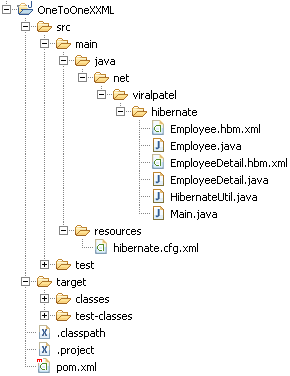Let us understand how One-to-one mapping works in Hibernate. Following is a simply yet concept building example where we will understand One-to-one mapping in Hibernate framework using XML Mappings. We will use two tables “employee” and “employeedetail” which exhibits one-to-one relationship. Using Hibernate we will implement this relationship.
[sc name=”Hibernate_Tutorials”] Tools and technologies used in this article:
File: /src/main/java/net/viralpatel/hibernate/EmployeeDetail.java

- Java JDK 1.5 above
- MySQL 5 above
- Eclipse 3.2 above
- Hibernate 3 above
- Maven 3 above
1. Create Database
We will use MySQL in our example. Create two tables “employee” and “employeedetail” with One-to-one relationship. Following is the SQL script for same./* EMPLOYEE table */
CREATE TABLE `employee` (
`employee_id` BIGINT(10) NOT NULL AUTO_INCREMENT,
`firstname` VARCHAR(50) NULL DEFAULT NULL,
`lastname` VARCHAR(50) NULL DEFAULT NULL,
`birth_date` DATE NOT NULL,
`cell_phone` VARCHAR(15) NOT NULL,
PRIMARY KEY (`employee_id`)
)
COLLATE='latin1_swedish_ci'
ENGINE=InnoDB
ROW_FORMAT=DEFAULT
AUTO_INCREMENT=216
/* EMPLOYEEDETAIL table */
CREATE TABLE `employeedetail` (
`employee_id` BIGINT(20) NOT NULL AUTO_INCREMENT,
`street` VARCHAR(50) NULL DEFAULT NULL,
`city` VARCHAR(50) NULL DEFAULT NULL,
`state` VARCHAR(50) NULL DEFAULT NULL,
`country` VARCHAR(50) NULL DEFAULT NULL,
PRIMARY KEY (`employee_id`),
CONSTRAINT `FKEMPL` FOREIGN KEY (`employee_id`) REFERENCES `employee` (`employee_id`)
)
COLLATE='latin1_swedish_ci'
ENGINE=InnoDB
ROW_FORMAT=DEFAULT
AUTO_INCREMENT=216
Code language: SQL (Structured Query Language) (sql)2. Hibernate Maven dependency
Following dependencies we will use in Maven which will add Hibernate support. File: /pom.xml<project xmlns="http://maven.apache.org/POM/4.0.0"
xmlns:xsi="http://www.w3.org/2001/XMLSchema-instance"
xsi:schemaLocation="http://maven.apache.org/POM/4.0.0 http://maven.apache.org/maven-v4_0_0.xsd">
<modelVersion>4.0.0</modelVersion>
<groupId>net.viralpatel.hibernate</groupId>
<artifactId>HibernateHelloWorldXML</artifactId>
<packaging>jar</packaging>
<version>1.0-SNAPSHOT</version>
<name>HibernateHelloWorldXML</name>
<url>http://maven.apache.org</url>
<dependencies>
<dependency>
<groupId>mysql</groupId>
<artifactId>mysql-connector-java</artifactId>
<version>5.1.10</version>
</dependency>
<dependency>
<groupId>org.hibernate</groupId>
<artifactId>hibernate</artifactId>
<version>3.2.6.ga</version>
</dependency>
</dependencies>
</project>
Code language: HTML, XML (xml)3. Hibernate Model class
For this example we will create two Model class: Employee.java and EmployeeDetail.java. Add following in your project. File: /src/main/java/net/viralpatel/hibernate/Employee.javapackage net.viralpatel.hibernate;
import java.sql.Date;
public class Employee {
private Long employeeId;
private String firstname;
private String lastname;
private Date birthDate;
private String cellphone;
private EmployeeDetail employeeDetail;
public Employee() {
}
public Employee(String firstname, String lastname, Date birthdate,
String phone) {
this.firstname = firstname;
this.lastname = lastname;
this.birthDate = birthdate;
this.cellphone = phone;
}
// Getter and Setter methods
}
Code language: Java (java)File: /src/main/java/net/viralpatel/hibernate/EmployeeDetail.java
package net.viralpatel.hibernate;
public class EmployeeDetail {
private Long employeeId;
private String street;
private String city;
private String state;
private String country;
private Employee employee;
public EmployeeDetail() {
}
public EmployeeDetail(String street, String city, String state, String country) {
this.street = street;
this.city = city;
this.state = state;
this.country = country;
}
// Getter and Setter methods
}
Code language: Java (java)4. Hibernate XML Mapping (HBM)
Add following hibernate mapping (hbm) filesEmployee.hbm.xml and EmployeeDetail.hbm.xml for the model classes created in above steps. File: /src/main/java/net/viralpatel/hibernate/Employee.hbm.xml<?xml version="1.0" encoding="UTF-8"?>
<!DOCTYPE hibernate-mapping PUBLIC
"-//Hibernate/Hibernate Mapping DTD 3.0//EN"
"http://hibernate.sourceforge.net/hibernate-mapping-3.0.dtd">
<hibernate-mapping package="net.viralpatel.hibernate">
<class name="Employee" table="EMPLOYEE">
<id name="employeeId" column="EMPLOYEE_ID">
<generator class="native" />
</id>
<one-to-one name="employeeDetail" class="net.viralpatel.hibernate.EmployeeDetail"
cascade="save-update"></one-to-one>
<property name="firstname" />
<property name="lastname" column="lastname" />
<property name="birthDate" type="date" column="birth_date" />
<property name="cellphone" column="cell_phone" />
</class>
</hibernate-mapping>
Code language: HTML, XML (xml)<?xml version="1.0" encoding="UTF-8"?>
<!DOCTYPE hibernate-mapping PUBLIC
"-//Hibernate/Hibernate Mapping DTD 3.0//EN"
"http://hibernate.sourceforge.net/hibernate-mapping-3.0.dtd">
<hibernate-mapping package="net.viralpatel.hibernate">
<class name="EmployeeDetail" table="EMPLOYEEDETAIL">
<id name="employeeId" type="java.lang.Long">
<column name="EMPLOYEE_ID" />
<generator class="foreign">
<param name="property">employee</param>
</generator>
</id>
<one-to-one name="employee" class="net.viralpatel.hibernate.Employee"
constrained="true"></one-to-one>
<property name="street" column="STREET"/>
<property name="city" column="CITY"/>
<property name="state" column="STATE"/>
<property name="country" column="COUNTRY"/>
</class>
</hibernate-mapping>
Code language: HTML, XML (xml)5. Hibernate Configuration
Following is the hibernate configuration hibernate.cfg.xml file. Add this in your project. File: /src/main/resources/hibernate.cfg.xml<?xml version='1.0' encoding='utf-8'?>
<!DOCTYPE hibernate-configuration PUBLIC
"-//Hibernate/Hibernate Configuration DTD 3.0//EN"
"http://hibernate.sourceforge.net/hibernate-configuration-3.0.dtd">
<hibernate-configuration>
<session-factory>
<property name="connection.driver_class">com.mysql.jdbc.Driver</property>
<property name="connection.url">jdbc:mysql://localhost:3306/tutorial</property>
<property name="connection.username">root</property>
<property name="connection.password"></property>
<property name="connection.pool_size">1</property>
<property name="dialect">org.hibernate.dialect.MySQLDialect</property>
<property name="current_session_context_class">thread</property>
<property name="cache.provider_class">org.hibernate.cache.NoCacheProvider</property>
<property name="show_sql">true</property>
<property name="hbm2ddl.auto">validate</property>
<mapping resource="net/viralpatel/hibernate/EmployeeDetail.hbm.xml"/>
<mapping resource="net/viralpatel/hibernate/Employee.hbm.xml"/>
</session-factory>
</hibernate-configuration>
Code language: HTML, XML (xml)6. Hibernate Utility class
File:/src/main/java/net/viralpatel/hibernate/HibernateUtil.javapackage net.viralpatel.hibernate;
import org.hibernate.SessionFactory;
import org.hibernate.cfg.Configuration;
public class HibernateUtil {
private static final SessionFactory sessionFactory = buildSessionFactory();
private static SessionFactory buildSessionFactory() {
try {
// Create the SessionFactory from hibernate.cfg.xml
return new Configuration()
.configure()
.buildSessionFactory();
} catch (Throwable ex) {
System.err.println("Initial SessionFactory creation failed." + ex);
throw new ExceptionInInitializerError(ex);
}
}
public static SessionFactory getSessionFactory() {
return sessionFactory;
}
}
Code language: Java (java)7. Main class to test One-to-one mapping
Add following Main.java class in your project to test One-to-one relationship mapping functionality. File:/src/main/java/net/viralpatel/hibernate/Main.javapackage net.viralpatel.hibernate;
import java.sql.Date;
import java.util.List;
import org.hibernate.Session;
import org.hibernate.SessionFactory;
public class Main {
public static void main(String[] args) {
SessionFactory sf = HibernateUtil.getSessionFactory();
Session session = sf.openSession();
session.beginTransaction();
EmployeeDetail employeeDetail = new EmployeeDetail("10th Street", "LA", "San Francisco", "U.S.");
Employee employee = new Employee("Nina", "Mayers", new Date(121212),
"114-857-965");
employee.setEmployeeDetail(employeeDetail);
employeeDetail.setEmployee(employee);
session.save(employee);
List<Employee> employees = session.createQuery("from Employee").list();
for (Employee employee1 : employees) {
System.out.println(employee1.getFirstname() + " , "
+ employee1.getLastname() + ", "
+ employee1.getEmployeeDetail().getState());
}
session.getTransaction().commit();
session.close();
}
}
Code language: Java (java)8. Review Project Structure
Below is the final project structure with all the source files.
8. Execute the example
Execute the Main class. Hibernate will insert a row in Employee and EmployeeDetail table. Output:Code language: HTML, XML (xml)Hibernate: insert into EMPLOYEE (firstname, lastname, birth_date, cell_phone) values (?, ?, ?, ?) Hibernate: insert into EMPLOYEEDETAIL (STREET, CITY, STATE, COUNTRY, EMPLOYEE_ID) values (?, ?, ?, ?, ?) Hibernate: select employee0_.EMPLOYEE_ID as EMPLOYEE1_1_, employee0_.firstname as firstname1_, employee0_.lastname as lastname1_, employee0_.birth_date as birth4_1_, employee0_.cell_phone as cell5_1_ from EMPLOYEE employee0_ Hibernate: select employeede0_.EMPLOYEE_ID as EMPLOYEE1_0_0_, employeede0_.STREET as STREET0_0_, employeede0_.CITY as CITY0_0_, employeede0_.STATE as STATE0_0_, employeede0_.COUNTRY as COUNTRY0_0_ from EMPLOYEEDETAIL employeede0_ where employeede0_.EMPLOYEE_ID=? Nina , Mayers, San Francisco



Hi Viral,
Its a lovely post and really appriciated your efforts but i have one doubt only, that is, suppose if i want to create a JSP form which contains both the tables details/columns, how can i do that cause In controll class i will create an instance of Employe.java and will declear all the fields on JSP like but how will i declear ‘EmployeeDetails’ variable on my JSP if i try ’employeeDetails.street’ against any then it doesn’t identify and gives error.
so in nutshell my requirement is i have form which have all fields exists on employee and employeeDetails table, how will i declear subTable columns on my JSP page ?
Can you/anyone please guide me for this.
Thanks
Hi Tapan,
The EmployeeDetail is part of Employee object. You can simply pass Employee object to JSP and render all attributes as:
Hope this works.
Hi,
It’s awesome man.
but can you suggest how to read some data from a text file and check whether these values are the same in a table through HIBERNATE XML and annotations too.
Thanks a lot
Hi Ajay,
Your requirement seems to be very specific. All you need to do is to
1) Read a text file in Java using File IO.
2) Iterate through the data in file
3) Use Hibernate to check if data is present by query the db.
Hi , i want to know about
this
employee
What is this pram tag and its “property” attribute
Hi , i want to know about
employee
What is this pram tag and its “property” attribute
employee
What is this param tag and its “property” atribute
Nice Article viral :)
Very helpful
Thanks,
Anil
Thanks A lot man :D
Thanx man. Nice tutorial
Hi James! I’m with you because I just ululsay put my PC into hibernate mode. And although, it’s not difficult to make some few clicks to hibernate a PC, but if there’s an easier way I would appreciate it very much. It’s just through this post that I learned to personalize the power button and I just did it! Thanks to you a lot!
Hi there,
i got an error when i run my test for the second times and it thow me the error: “Oct 25, 2012 3:21:52 PM org.hibernate.impl.SessionFactoryObjectFactory addInstance
INFO: Not binding factory to JNDI, no JNDI name configured
org.hibernate.SessionException: Session is closed!
Exception in thread “main” java.lang.NullPointerException
at geomancer.utils.testHibernateConnection.main(testHibernateConnection.java:32)
at org.hibernate.impl.AbstractSessionImpl.errorIfClosed(AbstractSessionImpl.java:49)
at org.hibernate.impl.SessionImpl.list(SessionImpl.java:1541)
at org.hibernate.impl.CriteriaImpl.list(CriteriaImpl.java:283)
at geomancer.utils.testHibernateConnection.main(testHibernateConnection.java:27)
Java Result: 1
i don’t why, but the first times is ok
It’s very very helpful tutorial…………………
Hi Viral,
I have two tables with composite id having one to one relationship.
Table One : PK Columns : column1, column2
Table Two : PK Columns : column3, column4.
Columns are having different names. I have to map column1 – column3 and column2-column4.
How to give one to one association in xml configuration.
mapping instance can not be created ..exception
Thanks so much!! you saved my life :D
I’m trying to insert only child details with parent already present .Can you please help with it.
Using above method but instead of creating new object of employee getting it from datasource.
Getting error “not-null property references a null or transient value
Check nullability
Hi Viral,
You have not do session.save(employeedetail)
so without this, is it okay?
Thanks for your reply.
Hi sherry,
emplyee is a object of Employee(ownerClass) class in EmployeeDetails(ownedClass). property emplyee specifiy, that owned class will take employee id as foreign key.
Pls explain it constrained=”true”
I got the explanation in hibernate forum
Hi, constrained=”true” is use in case of shared primary key. (in case of parent child relationship, when child’s primary key works as foreign key pointing to primary key of parent)..
Equivalent annotation is
@PrimaryKeyJoinColumn
https://forum.hibernate.org/viewtopic.php?f=1&t=975113
Thanx its very nice tutorial ……
I have an issue with composition where one class has another:
public class InventoryItem {
Ingredient ingredient;
}
I want to store the IngredientID in my Inventory table as a foreign key to the Ingredient table. Unfortunately, Ingredient is an abstract class with three concrete subclasses. I do not know how to map this properly and haven’t seen any info anywhere. Any ideas?
Thanks a lot!
It was really briefly and clearly!
Very helpful thanks
Hi Mr. Patel,
It was a very nice example to understand one-to-one mapping in hibernate and I really appreciate ur efforts to explain it in such a simple way. However I have a doubt. We r getting the employeeDetails data in the employee table. But is the inverse also possible i.e If i query employeeDetails data will that object also contain the employee data. Actually I am trying to implement similar thing in my project but am facing dome issues. Can u please shed some light on this.
Thankx
very nice tutorial. i got confusesd with the system.out.println as it was showing only some data. changed to:
and now is the full data :P.
Thanks a lot.
Timi
Very good tutorial it works for me .thanks for sharing the article
Getting this error :
log4j:WARN No appenders could be found for logger (org.hibernate.cfg.Environment).
log4j:WARN Please initialize the log4j system properly.
log4j:WARN See http://logging.apache.org/log4j/1.2/faq.html#noconfig for more info.
org.hibernate.HibernateException: hibernate.cfg.xml not found
Exception in thread “main” java.lang.NullPointerException
at com.DAO.Main.main(Main.java:16)